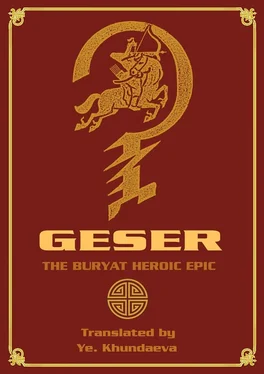Ye. Khundaeva - Geser. The Вuryat heroic epic
Здесь есть возможность читать онлайн «Ye. Khundaeva - Geser. The Вuryat heroic epic» — ознакомительный отрывок электронной книги совершенно бесплатно, а после прочтения отрывка купить полную версию. В некоторых случаях можно слушать аудио, скачать через торрент в формате fb2 и присутствует краткое содержание. ISBN: , Жанр: Языкознание, foreign_language, на английском языке. Описание произведения, (предисловие) а так же отзывы посетителей доступны на портале библиотеки ЛибКат.
- Название:Geser. The Вuryat heroic epic
- Автор:
- Жанр:
- Год:неизвестен
- ISBN:9785448558627
- Рейтинг книги:3 / 5. Голосов: 1
-
Избранное:Добавить в избранное
- Отзывы:
-
Ваша оценка:
- 60
- 1
- 2
- 3
- 4
- 5
Geser. The Вuryat heroic epic: краткое содержание, описание и аннотация
Предлагаем к чтению аннотацию, описание, краткое содержание или предисловие (зависит от того, что написал сам автор книги «Geser. The Вuryat heroic epic»). Если вы не нашли необходимую информацию о книге — напишите в комментариях, мы постараемся отыскать её.
Geser. The Вuryat heroic epic — читать онлайн ознакомительный отрывок
Ниже представлен текст книги, разбитый по страницам. Система сохранения места последней прочитанной страницы, позволяет с удобством читать онлайн бесплатно книгу «Geser. The Вuryat heroic epic», без необходимости каждый раз заново искать на чём Вы остановились. Поставьте закладку, и сможете в любой момент перейти на страницу, на которой закончили чтение.
Интервал:
Закладка:
There is a custom of hanging from a tree a Khii-morin (air horse), a personal votive flag for well – being and prosperity. This is connected with the honor and respect for horse. The horse is regarded as mediator between the Sky and the Earth. The horse plays one of the most important parts in the Geseriade and in the life of the Buryats, especially in the early ages.
There are the special rituals when building something. Earlier it was prohibited to dig ground not to damage its upper soil which was taken to be most fertile. It was needed to appease the spirits of the Earth, to calm them down, to ask them for the permisson to erect something. The spirits of the Earth get very angry when people without any reasonable excuse dig the ground, break stones and rocks, fell treеs, contaminate rivers and springs, throw the dirty things into the fire. One has to appease the gods and the spirits making offerings and addressing them with the invocations.
Before the battle the heroes of the epic complete the special rites. Geser is often shown going onto the top of a high mountain and praying. Before he starts his prayer he unbuttons his coat and takes off his belt.
Nature played a great role in the life of the Buryats as it is shown in the epical works. It is inseparable from the nomad¢s everyday life. It gives strength to the nomad, the latter receives from Nature his/her life energy. The idea of the cohesion of Man and Nature which is depicted in the Geseriade has been of great importance in all the times because the alternative idea would be non-acceptance of all the laws of Nature. Thus there were the numerous cults connected with Nature.
Hunting in the taiga had some territorial limitations, the hunters were well aware of the stock of the hunting areas, they had a good idea of how much game they could catch or kill in order to keep in balance the number of the wild animals, i.e. the food stock of the nomads. The latter abstained from hunting the she-animals, especially with the cubs and the young animals with no couple. Thus there was the cult of hunting and the Lord of the thick forest. Before going hunting the Buryats completed the special rites, among them chanting of the “Geser” verses.
The atmospheric phenomena are presented in the epic in the personages of the tengris. Among the 44 eastern tengris there are the tengris of the summer, autumn, winter mists, the black dirt, the black smoke. Among the 55 western tengris there are the following: the Tengri of the Upper Wind, the Tengri of the Fire, the Tengri of the Sun Warmth, the Tengri of the Rain, the Tengris of the Lightning and the Thunderstorm, the Tengri of the Snow, the Tengri of the White Bottom) or in the other words the cloudless sky, etc. The struggle takes place symbolically between the warmth and the cold; between the clear, sunny weather and the black nastiness; between the rain contributing to the growth of the vegetation which is favourable for the nomad-cattlebreeder and the drought.
The Geseriade evidences of the fact that the Buryats were noted for their ecological approach to Nature which presupposed the adaptation to the natural conditions. The form and the type of the dwellings, the utilitarian constructions, the tools, the clothes, the customs and the habits are chiеfly dependent on the climate, the geographical position, the flora, the fauna, the temperature and the other objective factors that gave rise to the numerous religious cults and rituals.
The proto-Buryats, i.e. the hunters and the collectors of the plants representing the forest tribe communities entered the new stage of the social and economic life brought about by the establishment of the paternal right much later than the ancestors of the other nomad tribes. The socio-economical ties were those of a tribal community and the Buryats did not undergo the process of the unification for a considerable period of time. Even in the end of the XIX century the Buryats somewhat preserved the patriarchal and tribal relations since the new tendencies did not display themselves so vividly in their economy for there were neither factories, nor railroads, nor electricity, etc. Due to fact the epic preserved itself almost in a pure form.
One should mention that the epic of Geser in its versified version which is believed to be the Buryat creation was preserved by the “western” Buryats, among whom most widely spread were the shaman rituals. One can say that the oral “Geser” and shamanism are to some extent interrelated. The versification and the shaman elements evidence of “Geser’s” being ancient since it is generally recognized that the most ancient epical works of the Mongolian people as well as the shaman invocations were in verse, not in prose. The epic “Geser” as well as the shamanism underwent the two gross pressures: one, that of the Buddhist authorities and the other, that of the Soviet period when it was persecuted as “anti-people”.
One can’t understand the essence of the current shamanic rituals without touching upon the old beliefs which the contemporaries hadn’t watched but which the epic and the other folklore pieces help reconstruct, though they underwent some changes.
Some functions of the Mongolian shamanism or boo are close to the bon belief, an ancient Tibetan belief. The epic of Geser was quite popular among the Tibetan bon-po communities. Some nomads take “Geser” to be an oral people’s monument of the bon epoch. They liked to recite or rather sing it to the musical instruments.
The mythological consciousness or religiousness revealed in the epical sources of the Mongolian tribes is of the diverse forms. At the early stages of its formation the religiousness reflected the primitive cults of the early communities. The epical material contains the evidences of such phenomena as the deities, spirits, souls of the ancestors, the added properties of the real objects or the fetishes as well as the “supernatural” relations amongst the objects of the material world (the magic, the totem). The ordinary religious consciousness or religious psychology as the epic evidences was being shaped out without any predetermined frame or rather chaotically at first sight. It was certainly the sensual reflection of the everyday life. In this period, the “infant” period of the evolution of man, of particular importance in his life were the feelings and frames of mind associated with the animistic, totemistic magic ideas which in their turn were related to the formation of shamanism, bon, the various cults, those of the Sun, Fire and the other natural objects.
The animistic ideas as one of the relics of the primitive religious syncretism penetrate the whole of the Mongolian and Buryat folklore and epic. Widely spread were the genealogical myths in which the cult of the mountain spirits is depicted. It is just the mountain spirit who appears to be in fact the father of Geser on the Earth. According to the epic the man possesses not one soul but a few of them. One soul is in the body, another may leave the body, the third soul may be somewhere else out of the body.
Very often the souls are of some zoomorphic form. There may be the two golden fish coming out of the mangus’ nostrils during his sleep. One might recollect the hero’s chasing of the three stags that had the soul of the mangus. In the Oirat epic the soul may be found in a copper-headed iron-winged raven that flies out of a cut-open breast of the mangus’ mother. The raven turns into a fish, a marmot. The hero chases it as an eagle, fish or marmot. In the demon’s body, both male and female, in one of the big toes or in one of his ninety five stomachs found not infrequently was an invulnerable baby combining in itself the features of the enemy’s unborn offsprings and of some powerful “inner strength” of the enemy.
Most often the birds and snakes or fish that present the universal cosmic symbols of the upper and the lower worlds come as the embodiments of the soul. A soul saving itself from pursuit flies into the sky as bird or plunges into the sea as fish. It might be associated with the dichotomy of the upper and the lower, e.g. the placement of the mangadkhai’s “golden seed of soul” firstly in the plume of Khankhan Kherdig bird (Garudi) whose nest is on top of an aspen growing on top of a high mountain, then in the stomach of a gigantic black frog, living in a yellow lake or the placement of another soul of the same mangadkhai embodied in the thirteen quails in a golden and silver box placed in a silver trunk in the yellow milk sea under the protection of a one-eyed woman whereas the soul of the hero is hidden in the western Heaven with the seven celestial smiths.
Читать дальшеИнтервал:
Закладка:
Похожие книги на «Geser. The Вuryat heroic epic»
Представляем Вашему вниманию похожие книги на «Geser. The Вuryat heroic epic» списком для выбора. Мы отобрали схожую по названию и смыслу литературу в надежде предоставить читателям больше вариантов отыскать новые, интересные, ещё непрочитанные произведения.
Обсуждение, отзывы о книге «Geser. The Вuryat heroic epic» и просто собственные мнения читателей. Оставьте ваши комментарии, напишите, что Вы думаете о произведении, его смысле или главных героях. Укажите что конкретно понравилось, а что нет, и почему Вы так считаете.











